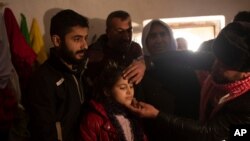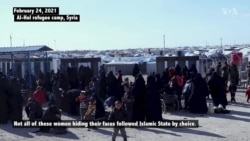At this camp in northeastern Syria, women are often seen wearing niqab, the dress that ultra-conservative Muslim women wear to cover their entire bodies, except for their eyes.
Nowadays, this religious attire serves another purpose: hide the identities of as many as 250 Yazidi women who were forced into sex slavery by Islamic State in 2014 after the terror group took their small town of Sinjar in northern Iraq.
Al-Hol is Syria’s largest camp for refugees and internally displaced persons, with a population of roughly 62,000. The United Nations says more than 80% of its residents are women and children.
Many of the camp’s female residents survived the 2014 genocide in Sinjar, where IS killed most of their brothers and fathers but kept them alive, forcing them to convert to Islam and marry its jihadist members. As a result, many of the women became mothers raising children fathered by members of IS.
More than six years later, many of these women prefer to be known as IS wives rather than members of the ancient religious group they were born into. They fear that by revealing their identities, they could permanently be separated from their children, according to experts and Yazidi survivors.
That fear remains, despite a decision made in 2019 by the Yazidi Supreme Spiritual Council to allow children born to IS fighters to live within the secluded community, reversing a previous stance the council held on the issue.
A Yazidi female survivor, who identified herself only as Layla, recently unveiled her identity to authorities.
“The Yazidi women all heard that if they returned to Sinjar, they would lose their children,” Layla told VOA. “Because of our children, we hid ourselves. However, when the decision was made that we can keep our children, I revealed myself.”
Jabir Jendo, a Syria-based researcher on the Yazidis, explained a dilemma from which Yazidi women have suffered.
“These women have children, and the fathers of these children are IS terrorists,” he said. “That has caused a problem for these women. They either had to abandon their children and return to their families or stay with their children and live the way they do now.”
Mahmoud Rasho, a member of the Syrian Yazidi Council, is helping to identify the Yazidi women who remain in hiding and wants to reassure them that they can continue to live with their children.
“We have information that some Yazidis are indeed inside the camp,” Rasho told VOA. “We are working to get those women out of the camp in phases.”
VOA talked to other female Yazidi survivors who said that despite returning to their communities, they continue to worry about their children’s futures, growing up with the stigma of being born to IS militants, also known as ISIS.
Some figures show an increase in suicide among Yazidi survivors. On Tuesday, Iraq’s Kurdistan Regional Government (KRG) announced that at least 13 Yazidi survivors have committed suicide so far this year.
“The suicides are believed to be linked to the trauma caused by the Yazidi genocide at the hands of ISIS, the difficult living conditions inside the(displacement) camps, lack of prospects for the future, and economic and social problems,” the KRG said.







